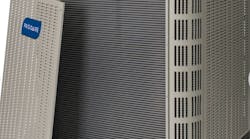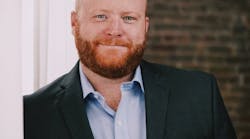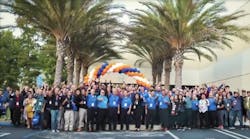Probably more than a few controls distributors rolled their eyes the first few times they heard the word "sustainability" as it relates to their businesses. Someone may have said to them, "Hey, sustainable building practices are really hot right now" or "If you don't incorporate sustainability into your business, you're really missing out."
Forgive the eye rollers. For who among HVACR distributors has not seen buzzwords come and go? But what if you, as a controls distributor, have been in the sustainability business all these years and didn't even know it? After all, sustainability is about using resources more effectively, minimizing the negative impact on the environment and making people more comfortable where they live and work. Isn't that the purpose of HVACR controls and systems?
Controls distributors that can successfully link sustainability back to building controls will separate themselves from their competitors, according to Paul Neustadt, president and owner of Downers Grove, IL-based Neuco Inc. and chair of HARDI's Controls Council. "I used to think that sustainability was kind of a tree-hugger thing, but after looking into it and doing some research, I think it can be an opportunity for growth for controls distributors," he says. "We're talking about building automation controls that control both the conditioning of the space as well as the lighting of the space."
The concept of sustainability as it relates to HVACR controls and systems has been around since the inception of the first building automation system, or energy management system (EMS), says Scott Cross, owner and CEO of Temperature Control Systems in Dallas and vice chair of the Controls Council. "The whole premise of the original EMS system was to have control and monitoring capabilities of a building from a centralized location and have better control and scheduling both for comfort and energy management," he says. Concepts such as sustainability often begin as buzzwords to grab attention, Cross says. While "only time will tell if it will gain traction," he believes that the sustainability message is indeed part of the building world today. It will continue to grow as the focus on energy savings and efficiency becomes a regular part of the conversation about how we manage buildings. Neustadt agrees with this assessment. "Sustainability is a topic that is not going to go away," he says. "It's becoming more and more relevant."
So what is driving sustainability in the controls business today? Many of the same considerations that drive other parts of the HVACR business: efficiency, energy savings and overall cost savings for the building owner.
"In a simple way, common sense and fiscal responsibility are the drivers of sustainable buildings," Neustadt says. "There are some simple things like having lights go off when no one is in the room that save energy and money for the building owner. There's also a growing awareness that our natural resources are not limitless and we need to be better stewards of what we have and how we use them."
Cross says he'll discuss the concepts of sustainability when working with some customers, but it's usually part of a larger discussion about the customers' needs. There often are many goals a customer seeks to achieve, and sustainability is only part of this strategy. "We do not use it exclusively with customers," he adds.
Neustadt and Cross say architects often are the primary drivers in influencing sustainable building practices, but facility owners are becoming increasingly aware of how these concepts can benefit them in many different ways — from the cost-savings to the marketing of their buildings to tenants. Neustadt says more facility owners are better educated in this area and are voicing their opinions about how controls can be best used to ensure sustainable practices.
Distributors can be key influencers with architects, engineers and facility owners when it comes to promoting the use of sustainable building practices in either new construction or retrofit projects. When distributors can speak with confidence about how controls and systems are critical to sustainable building practices, customers will rely on them for their knowledge.
"Studies have shown that people like to deal with companies that are leading in categories like sustainable building and LEED," Neustadt says. LEED stands for Leadership in Energy and Environmental Design. An internationally recognized green building certification system developed by the U.S. Green Building Council, it verifies that a building was designed and built using strategies to improve environmental performance.
Page 2 of 2
Both controls and systems distributors should play an active role in educating and informing customers. "They are the promoters, the educators, the technical experts and financial advisors," Cross says. Playing these various roles often involves presentations and discussions at the "C-suite" level, with the CEOs or CFOs of the customer or your customer's customers. "I think the key here is showing the contractor customer how he can make more money by showing that being sustainable is paramount," Neustadt adds.
Among HVACR systems, automation controls can play a large role in influencing energy savings. Controls distributors can point to occupancy sensors and set-back thermostats as items that customers can easily use to save energy dollars. Products such as independent control valves, variable frequency drives, power metering, access control and lighting control are among the products that Temperature Control Systems often promotes when working with customers on building projects that involve sustainable practices.
According to Cross, the system components that go into developing sustainable building practices do not stand alone in developing a sustainable building. "Systems are a framework required for sustainable building, but systems alone do not make a building a sustainable building," he says. "In order for a building to be sustainable, it requires more than just scheduling. It requires logic based on building activity and use coupled with the interoperability of electrical, lighting and access."
The recession dealt a blow to many construction projects around the country and this, in turn, may have temporarily slowed the growth of sustainable building practices. But that activity in the vertical markets of K-12 school buildings, government buildings and the hospitality industries remained strong and these projects largely incorporated sustainable building practices through the use of controls and systems, Cross notes.
Distributors are not alone in promoting sustainable controls and systems to clients. Neustadt and Cross say that manufacturers such as Johnson Controls, Honeywell, Kreuter and Siemens are all actively engaged in these efforts. At the Controls Council meeting held during the HARDI Annual Fall Conference, Derek Supple, Johnson Controls' sustainability manager, spoke about the opportunities that exist for controls distributors who promote solutions that are energy-efficient and environmentally friendly. A strong partnership between distributors and manufacturers will be essential as manufacturers continue to develop and promote controls and systems that provide comfort as well as economic benefits for building owners and occupants, he said.
"Indeed, manufacturers are becoming great sources of information for distributors, not only in the new technology department but in providing education and training targeted at distributors and their customers. Many groups across the United States can help educate distributors on how they can learn about — and profit from — incorporating sustainability strategies into their business," Neustadt says.
Michael Maynard is a business writer based in Providence, RI. He writes frequently on HVACR, construction and architecture issues. Contact him at [email protected].





